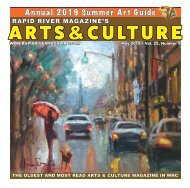February 2020 Issue
Works of art defining the contemporary age in WNC. Cover: ‘Downtown,’ 24x24, by Mark Bettis
Works of art defining the contemporary age in WNC.
Cover: ‘Downtown,’ 24x24, by Mark Bettis
You also want an ePaper? Increase the reach of your titles
YUMPU automatically turns print PDFs into web optimized ePapers that Google loves.
MANAGING NEGATIVE EMOTION<br />
ZEN PHILOSOPHY WITH BILL WALZ<br />
“No self, no suffering.” - Buddha<br />
Buddha is said to have stated, “I teach suffering,<br />
its origin, cessation and the path to its transcendence.<br />
That’s all I teach,” but what this is also saying<br />
is that The Buddha taught entering into a deep<br />
examination into negative, problematic human<br />
emotions - what causes them, and the means to<br />
effectively managing them. This is so important<br />
because no matter how “smart” we may be, there<br />
seems very little correlation between the kind<br />
of intelligence that makes a person an expert in<br />
some field of study, in the academic or professional<br />
worlds, and emotional stability. There may<br />
even be, in many cases, an inverse relationship<br />
where with higher and more complex intelligence,<br />
there is little practical wisdom and little of what is<br />
sometimes called “emotional IQ.”<br />
The Buddha taught that in all of Nature, humans,<br />
because of their evolved brains, are unique<br />
in their ability to create a virtual reality called<br />
culture and to develop techniques and tools for<br />
living in a complex and exploitive relationship with<br />
Nature. This is a good thing from the standpoint<br />
of greatly freeing humans from the dangers and<br />
limitations of Nature while releasing us to be<br />
creative, making ever-more complex culture and<br />
tools. But Buddha also realized there is a very big<br />
problem connected to this evolutionary human<br />
trait of complex brain function. To borrow from a<br />
modern paradigm drawn from the very complex<br />
tool of cybernetics, humans live in very much<br />
what are virtual realities constructed of information<br />
manipulated by these complex brains, and<br />
this virtual reality generates a sense of a virtual-reality-sense-of-self<br />
that psychology calls ego that<br />
is quite disconnected from our true nature and<br />
from Nature itself with serious consequences for<br />
both us humans and for Nature.<br />
Buddhism teaches a model of mind that considers<br />
thoughts and emotions to be mind-objects<br />
or forms that exist within the formless energy<br />
of mind-consciousness that individuates into<br />
awareness, the faculty for directing consciousness<br />
energy with its inherent intelligence into<br />
the examination of experience. In recognizing<br />
this multidimensional model of mind, Buddhism<br />
then gives us a methodology from which we can<br />
train in building skill at managing the contents of<br />
the mind by directing awareness into this examination.<br />
The Buddha further taught that having<br />
realized this dimension of awareness that can<br />
examine the contents and activity of mind, the<br />
insight becomes natural that we then must not<br />
be the contents, the thoughts and emotions, as<br />
most people assume and our culture reinforces.<br />
Rather, if awareness can examine the contents<br />
and activity of the mind, then who we fundamentally<br />
must be IS this awareness and not the<br />
contents and activity. We are not egos that have<br />
awareness; rather, we are awareness that has<br />
an ego structure so as to engage the world. This<br />
shifts our experience of mental activity from one<br />
that seems helpless in its management to one<br />
that is interactive and opens the way for skillful<br />
management.<br />
While Western education focuses intensely on<br />
feeding the mind full of information and ideas<br />
along with methods of logic for putting these<br />
ideas together effectively for utilitarian application,<br />
it teaches nothing about managing these<br />
contents in a manner so as to maximize mental<br />
stability, serenity and wisdom. The Buddhist<br />
model, on the other hand, emphasizes that we<br />
can manage mind through meditative techniques<br />
where mind examines mind, shining the light of<br />
awareness on the content of mind giving us perspective<br />
and insight, while developing awareness<br />
of awareness, allowing us to explore its potential<br />
for intuitive insight into the nature of existence.<br />
We discover that as awareness, we are free of the<br />
contradictions and imbalance of the egoic mind,<br />
and we can deepen the exploration of life lived as<br />
awareness, the dimension that is the true source<br />
of intelligence, creativity, wisdom and insight.<br />
To continue borrowing metaphor from the<br />
cybernetic world, as the saying goes: “Garbage<br />
in, garbage out” and any crazy thing can be<br />
programmed into these computer-brains of ours,<br />
much of it being completely contradictory and at<br />
odds with actual reality. Most importantly, these<br />
reality-virtualizing brains generating a virtual-self<br />
experiences itself as unique and separate from<br />
all else in the world, and this virtual-self is acutely<br />
aware of its vulnerability and its mortality; living in<br />
a story of itself in time, the past defining us and<br />
the future challenging us. This sense of limitation,<br />
vulnerability and dependency on the external<br />
world for stability and validation, and the too-often<br />
failure of the external world to provide consistency<br />
and validation, causes the contents of mind<br />
to be all too often marked by anxiety, frustration<br />
and unhappiness.<br />
At the core of most negative emotional experience<br />
- of depression, anxiety, anger and loneliness<br />
- is an exaggerated sense of this virtual-self<br />
in personal isolation along with a time-focus in<br />
the past or future. Most of the time, our focus of<br />
attention is on our “self” in our story-line in time<br />
that is too often distressing. Even anger, which<br />
in a given moment seems to be present-moment<br />
activated, has a strong component of residual<br />
past distress and disappointment brought into<br />
the present situation and is often carried quite<br />
inappropriately into the future, the ego chewing<br />
on its grievance over and over. The world, with<br />
the exception of whatever or whoever may be<br />
the focus of stimulating the emotion, has receded<br />
far into the background of our attention. Even<br />
the stimulating event or person is being experienced<br />
principally in its distressing connection to<br />
self, not in its larger context which would give<br />
the experience more sense and proportion, and<br />
thus greater acceptability. The world has to some<br />
inappropriate degree collapsed into the situation,<br />
thoughts and emotions orbiting our focus on our<br />
self.<br />
Buddhism recognizes this and teaches us to<br />
realize the antidote to such a perception is to<br />
‘Walz’ continued on page 23<br />
VOL. 23, NO. 6 — FEBRUARY <strong>2020</strong> | RAPIDRIVERMAGAZINE.COM | RAPID RIVER’S ARTS & CULTURE | 21















